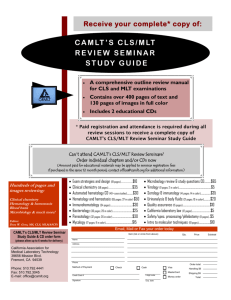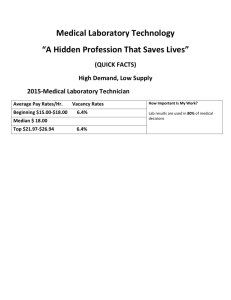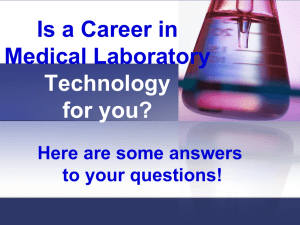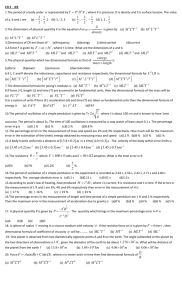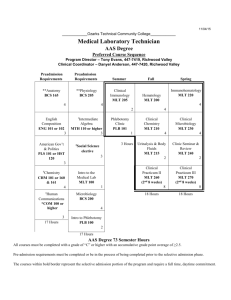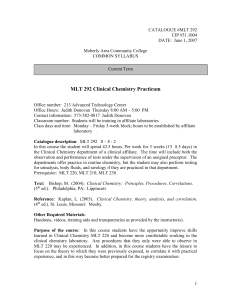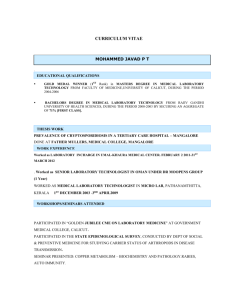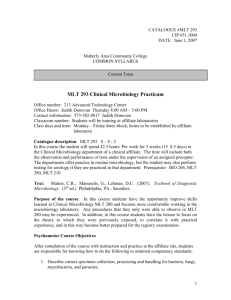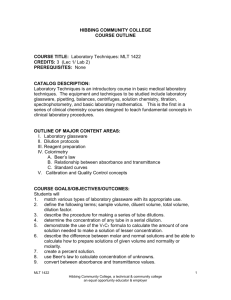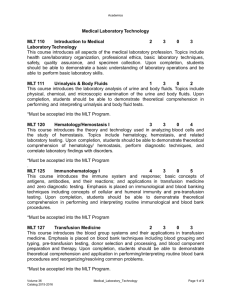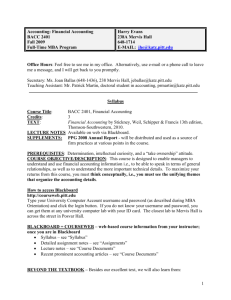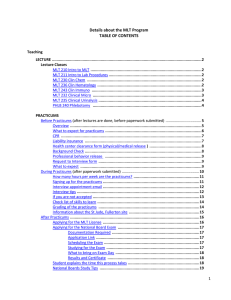Medical Lab Tech Information
advertisement
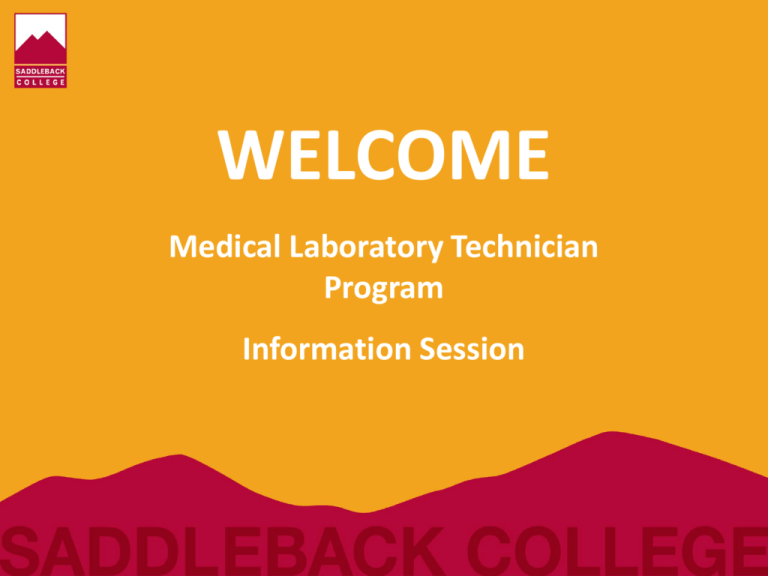
WELCOME Medical Laboratory Technician Program Information Session Medical Laboratory Technician • The Medical Laboratory Technician (MLT) program prepares students for employment as an MLT working in a clinical medical laboratory. They perform a wide variety of routine laboratory procedures and work in both public and private laboratories. • It is a 2-3 year curriculum leading to an Associates in Science degree. • The pay is roughly $40,000-$60,000 per year. • There are expected to be about 200,000 new jobs per year in this field. • It is one of the fastest growing careers in the Nation! What are MLT job duties? • Medical laboratory technicians (MLTs) perform a wide variety of routine laboratory procedures associated with tissue, blood and body-fluid analysis. • Students learn to perform routine laboratory procedures in phlebotomy, microbiology, clinical chemistry, hematology, coagulation, immunology, and urinalysis. • They also will learn to operate and maintain clinical laboratory equipment. • They provide information for patient diagnosis and treatment by performing laboratory tests in toxicology, chemistry, hematology, immunology, and microbiology laboratories; receiving, typing, testing, and recording blood bank inventories. Job Duties • Organizes work by matching computer orders with specimen labeling; sorting specimens; checking labeling; logging specimens; arranging reports for delivery; keeping work surfaces clean and orderly. • Maintains quality results by running standards and controls, verifying equipment function through routine equipment maintenance and advanced trouble shooting; calibrating equipment utilizing approved testing procedures; monitoring quality control measures and protocols. • Serves as technical resource by participating in staff training; answering questions of other professionals; participating in educational opportunities; reading professional publications; maintaining personal networks; participating in professional organizations. Job Duties • Identifies and communicates abnormal patient conditions by alerting supervisory personnel, the pathologist, the patient physician, or nurse; reporting mandated information to the public health department or other designated officials. • (toxicology) identifies the presence or quantity of drugs of abuse, therapeutic drugs, and toxic substances by operating toxicology instrumentation and performing manual methods for the performance of drug screens, blood alcohol levels, and carbon monoxide levels. • (chemistry) provides test results for patient diagnosis and treatment by operating chemistry equipment; performing hand chemistries. • (hematology) provides test results for patient diagnosis and treatment by operating hematology, urinalysis, and coagulation equipment; performing manual methods of differentials. Job Duties • (immunology) provides test results for patient diagnosis and treatment by operating equipment such as the gamma counter, spectrophotometer, densitometer, and through methods such as radioimmunoassay, enzyme immunossay, and serological testing. • (microbiology) provides physician with information for treatment of patient infection by performing technical procedures for the identification or susceptibility of bacteria, parasites, fungi, and mycobacteria. • (blood bank) ensures the patient of receiving compatible blood/blood components by completing blood typing, antibody screening, compatibility testing, and antibody identification procedures. • (blood bank) assures future retrieval of patient transfusion information by preparing patient packets and maintaining blood bank database. Job Duties • Contributes to a safe and secure environment for patients, visitors, physicians and co-workers by following established standards and procedures; complying with legal regulations. • Maintains patientconfidence by keeping laboratory information confidential. • Serves and protects the hospital community by adhering to professional standards, hospital policies and procedures, federal, state, and local requirements, and jcaho standards. • Enhances laboratory services and hospital reputation by accepting ownership for accomplishing new and different requests; exploring opportunities to add value to job accomplishments. How much do they make? • They make $20-28/hour, or $35,000-$60,000 per year. Average in California is $47,000. The middle 50 percent earned between $34,280 and $40,180, and the highest 25 percent earning $57,103. • The ones that make the most money work in Pharmaceutical and Medicine Manufacturing, Offices of Dentists, and Individual and Family Services. What are their hours like? • They work full time or part time, various shifts available, depending on the facility. • The most common hospital shift is 6am-2:30pm or 7am – 3:30 pm. Where do they work? • Both public and private laboratories serving the health care sector, such as General Medical and Surgical Hospitals, Medical and Diagnostic Laboratories, Offices of Physicians, Outpatient Care Centers, Other Ambulatory Health Care Services, and blood bank centers. They also work in pharmaceutical manufacturing. What are some company benefits? • Retirement, Medical insurance, vacation How long does it take to get degree/license • One year of classes, then it might be about one year of waiting for a practicum site, then 19 weeks of clinical rotations for the practicums. • Associate in Science Degree • Completion of the certificate program and a minimum of 60 units including the general education requirements with an overall GPA of 2.0 qualifies the student for the Associate in Science degree. A minimum of 12 units must be completed at Saddleback College. What grades do they need? • Must have 75% or higher in each class to pass, or need to re-take. • Classes are offered only once a year. • You cannot score lower than 75% in a class more than twice. • That means you can retake a class twice, or retake 2 different classes, but not more than that or you would be expelled from the program. What classes do they take? • Prerequisites to be completed before applying to the MLT Program: • Bio 15 (General Microbiology; 5 units) • Bio 113 (Human Anatomy & Physiology, one semester course; 4 units) • Chem 108 (Introduction to general, organic, and biochemistry; 4 units) • Math 253 (Intermediate Algebra; 5 units) Courses to complete in the MLT Program • FALL SEMESTER • MLT 210 (Intro to MLT; 1st 8 weeks; 1 unit); this course is also offered the summer before the first semester. • MLT 211 (Lab Procedures; 2nd 8 weeks; 1 unit) • MLT 230 (Clinical Chemistry; 5 units) • MLT 236 (Clinical Hematology and Coagulation; 3 units) • • • • SPRING SEMESTER MLT 232 (Clinical Microbiology; 3 units) MLT 235 (Clinical Urinalysis; 2nd 8 weeks; 1 unit) MLT 243 (Clinical Immunology) • CLASS TO TAKE WITH AMERICAN RED CROSS • Healthcare Provider CPR; coarse costs about $50 (license will be good for 2 years and then it must be renewed by taking a shorter course) • SUMMER SEMESTER or anytime at another school • Phlebotomy (8 week course on Saturdays 8am – 5pm; 4 units) • After completion of this class, the student must complete 60 hours of phlebotomy training at a clinical site (2 units). There are not enough sites to get all students in the subsequent Fall semester, so it might take a year or longer to fulfil this requirement. The license required is either CPT level 1 or 2. Clinical Rotations Before you can start the clinical rotations, you need the following things • Need to have a phlebotomy license or finished course • Need to have a valid CPR card ($50) • Need to pass a criminal background check ($43). Cannot have any arrests in the past 7 years. • Need to be current on the required immunizations and have a physical exam by a doctor, then be cleared through the Student Health Center. See end of document for list. • Need to purchase liability insurance ($21 per year) Immunization List PRACTICUMS AT CLINICAL SITES • After the above classes are completed, and the phlebotomy license and CPR card are submitted to the HS Office, and the student has cleared a background check (cost is $43), health clearance (including updated immunizations), and has purchased liability insurance (about $21 per year), students will then be set up for interviews for the following rotations at clinical sites. Since there are not enough sites for all the students, it might take a year or more to start these rotations. Some students are not accepted by any sites, even after three interviews. This is often caused from lack of adequate English skills. Students are advised to take courses such as Conversational English • MLT 242 (Clinical Chemistry Practicum; 4 units) • MLT 244 (Clinical Hematology/Coagulation Practicum; 4 units) • MLT 252 (Clinical Microbiology Practicum; 4 units) • MLT 253 (Clinical Immunology Practicum; 3 units) NATIONAL BOARD EXAM • After completion of all classes and practicums at the clinical sites, must take the National Board exam through ASCP (American Society of Clinical Pathologists). • This exam must be passed within 5 years after completion of all classes and practicum rotations. You do not get your MLT license until after you pass this exam. To get the license, go to https:??secure.cps.ca.gov/cltreg/ and apply online. Application fee is $200. It takes 150 days to process. How to Apply – We accept applications in June 1-12 (M-F 8:30 am to 4:30pm). The first students who turn their completed papers in to the HS Office are the ones who are accepted. Classes start two months later, in August. Program Applications and unofficial transcripts must be hand-delivered to the Health Sciences Division Office. Official transcripts must be on file with Saddleback College Admissions and Records before you can register for MLT classes – If students come to the office with all the documents listed on the application, they get accepted to the program, first come, first served.
